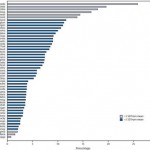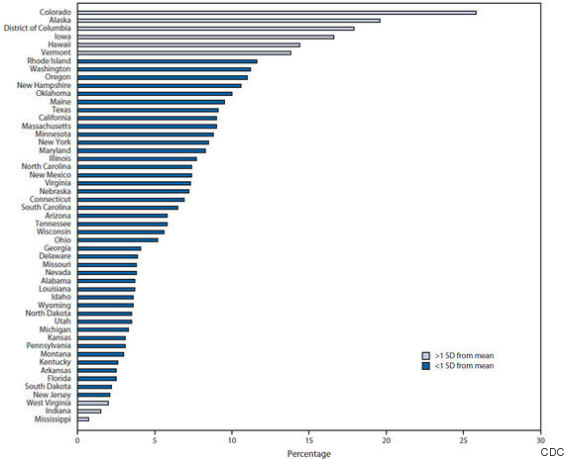
By: Rachael Rettner, LiveScience Senior Writer Published: 04/07/2015 02:14 PM EDT on LiveScience More U.S. teens are using long-term forms of birth control that they don’t have to remember every day, but these methods are still relatively uncommon, according to a new report from the Centers for Disease Control and Prevention. In 2013, among teens seeking birth control, 7.1 percent used intrauterine devices (IUDs) or birth control implants , whereas just 0.4 percent of these teens used one of these methods in 2005, the study found. Use of these methods varied widely by state: In 2013, nearly 26 percent of teens seeking birth control in Colorado used IUDs or implants, compared to just 0.7 percent in Mississippi. Because these methods, known as long-acting reversible contraception (LARC), are …
By: Rachael Rettner, LiveScience Senior Writer
Published: 04/07/2015 02:14 PM EDT on LiveScience
More U.S. teens are using long-term forms of birth control that they don’t have to remember every day, but these methods are still relatively uncommon, according to a new report from the Centers for Disease Control and Prevention.
In 2013, among teens seeking birth control, 7.1 percent used intrauterine devices (IUDs) or birth control implants , whereas just 0.4 percent of these teens used one of these methods in 2005, the study found. Use of these methods varied widely by state: In 2013, nearly 26 percent of teens seeking birth control in Colorado used IUDs or implants, compared to just 0.7 percent in Mississippi.
Because these methods, known as long-acting reversible contraception (LARC), are the most effective types of birth control for teens, more efforts are needed to increase access to them, the CDC says.
“Health care professionals have a powerful role to play in reducing teen pregnancy. They can encourage teens not to have sex, and discuss the use of IUDs and implants as contraceptive options available to teens who choose to be sexually active,” Ileana Arias, principal deputy director at the CDC, said in a statement. “We need to remove barriers and increase awareness, access and availability” of these methods for teens, Arias said. [Teen Pregnancy Rates By State]
Although the U.S. teen birth rate has declined in recent years, there were still more than 273,000 children born to teens ages 15 to 19 in 2013.
LARC methods are safe for teens, and unlike birth control pills or condoms, they do not require that people remember to do something each day or every time they have sex, the CDC says. Over a year of “real life” use, less than 1 percent of LARC users become pregnant, compared to 9 percent of women who use birth control pills and 18 percent who use condoms. Recently, the American Academy of Pediatrics recommended LARC as the first-choice birth control for teens.
In the new study, researchers analyzed information from more than 7.5 million teens who sought contraception from family planning centers funded by a federal grant program known as Title X.
The number of teens using LARC at these sites increased from 4,112 in 2005 to 43,696 in 2013, according to the report. Most of the increase was due to more teens using implants that are placed under the skin in the upper arm: In 2013, there were 26,347 users of such implants, compared 17,349 users of IUDs.
LARC use was highest in the West, with 9.5 percent of teens in that region using these methods, and lowest in the South, with 5.3 percent of teens using these methods. Besides Colorado, other states with high use of LARC included Alaska (19.6 percent), Iowa (16.6 percent) and Hawaii (14.4 percent), while states with low LARC use included West Virginia (2.0 percent) and Indiana (1.5 percent).

This graph shows the percentage of teens (ages 15 to 19 years old) in each state who used long-acting forms of birth control, among those seeking birth control. Click here to enlarge image.
(Image Credit: CDC)
The report describes some barriers to LARC use for teens, including that many teens know little about these methods. Additionally, providers may have unfounded concerns about the methods’ safety for teens or may not be trained in how to insert or remove the devices.
“Removing barriers to LARC by educating providers that LARC is medically safe for teens, training providers on LARC insertion and a client-centered counseling approach that includes discussing the most effective contraceptive methods first, and providing contraception at reduced or no cost to the client, can increase the array of options available to teens and may contribute to the continuing declines in teen pregnancy in the United States,” the report says.
The Title X program funds training in IUD and implant insertion and removal, and provides these birth control options at low or no cost, the CDC says.
Because LARC methods do not prevent sexually transmitted diseases, it’s recommends that they be used with condoms.
Follow Rachael Rettner @RachaelRettner. Follow Live Science @livescience, Facebook & Google+. Original article on Live Science.
- Blossoming Body: 8 Odd Changes That Happen During Pregnancy
- 10 Facts Every Parent Should Know about Their Teen’s Brain
- The History and Future of Birth Control
Copyright 2015 LiveScience, a Purch company. All rights reserved. This material may not be published, broadcast, rewritten or redistributed.
— This feed and its contents are the property of The Huffington Post, and use is subject to our terms. It may be used for personal consumption, but may not be distributed on a website.
Original article:



















